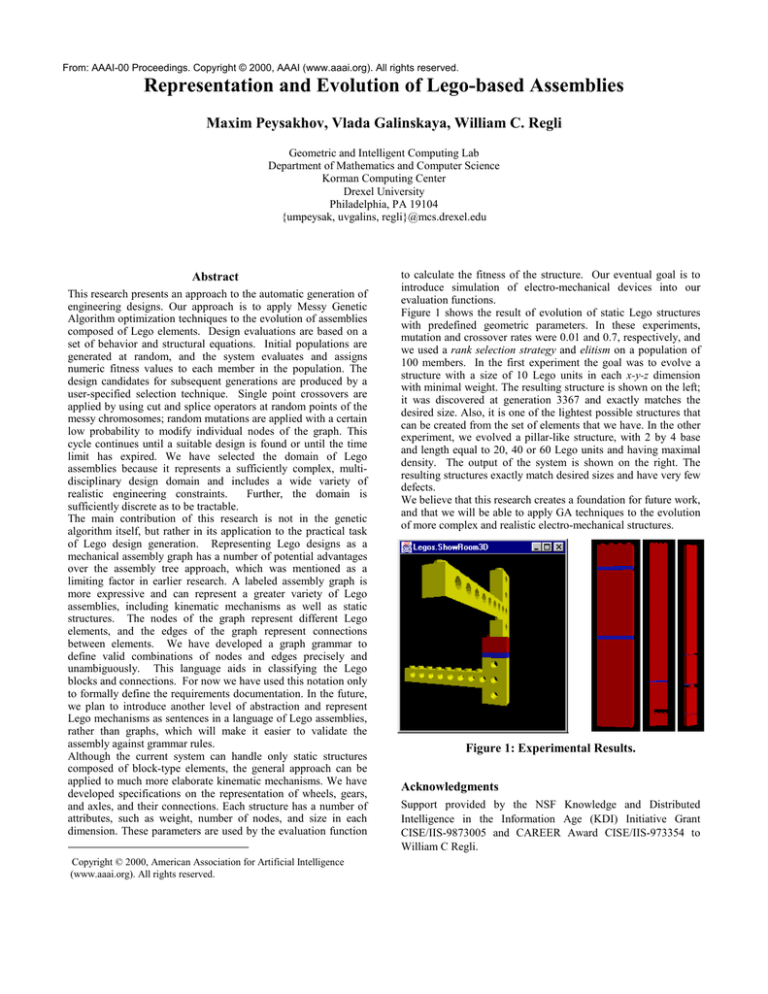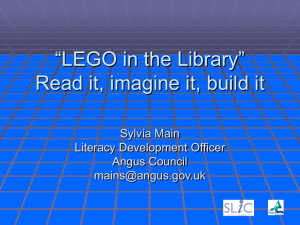
From: AAAI-00 Proceedings. Copyright © 2000, AAAI (www.aaai.org). All rights reserved.
Representation and Evolution of Lego-based Assemblies
Maxim Peysakhov, Vlada Galinskaya, William C. Regli
Geometric and Intelligent Computing Lab
Department of Mathematics and Computer Science
Korman Computing Center
Drexel University
Philadelphia, PA 19104
{umpeysak, uvgalins, regli}@mcs.drexel.edu
Abstract1
This research presents an approach to the automatic generation of
engineering designs. Our approach is to apply Messy Genetic
Algorithm optimization techniques to the evolution of assemblies
composed of Lego elements. Design evaluations are based on a
set of behavior and structural equations. Initial populations are
generated at random, and the system evaluates and assigns
numeric fitness values to each member in the population. The
design candidates for subsequent generations are produced by a
user-specified selection technique. Single point crossovers are
applied by using cut and splice operators at random points of the
messy chromosomes; random mutations are applied with a certain
low probability to modify individual nodes of the graph. This
cycle continues until a suitable design is found or until the time
limit has expired. We have selected the domain of Lego
assemblies because it represents a sufficiently complex, multidisciplinary design domain and includes a wide variety of
realistic engineering constraints.
Further, the domain is
sufficiently discrete as to be tractable.
The main contribution of this research is not in the genetic
algorithm itself, but rather in its application to the practical task
of Lego design generation. Representing Lego designs as a
mechanical assembly graph has a number of potential advantages
over the assembly tree approach, which was mentioned as a
limiting factor in earlier research. A labeled assembly graph is
more expressive and can represent a greater variety of Lego
assemblies, including kinematic mechanisms as well as static
structures. The nodes of the graph represent different Lego
elements, and the edges of the graph represent connections
between elements. We have developed a graph grammar to
define valid combinations of nodes and edges precisely and
unambiguously. This language aids in classifying the Lego
blocks and connections. For now we have used this notation only
to formally define the requirements documentation. In the future,
we plan to introduce another level of abstraction and represent
Lego mechanisms as sentences in a language of Lego assemblies,
rather than graphs, which will make it easier to validate the
assembly against grammar rules.
Although the current system can handle only static structures
composed of block-type elements, the general approach can be
applied to much more elaborate kinematic mechanisms. We have
developed specifications on the representation of wheels, gears,
and axles, and their connections. Each structure has a number of
attributes, such as weight, number of nodes, and size in each
dimension. These parameters are used by the evaluation function
1
Copyright © 2000, American Association for Artificial Intelligence
(www.aaai.org). All rights reserved.
to calculate the fitness of the structure. Our eventual goal is to
introduce simulation of electro-mechanical devices into our
evaluation functions.
Figure 1 shows the result of evolution of static Lego structures
with predefined geometric parameters. In these experiments,
mutation and crossover rates were 0.01 and 0.7, respectively, and
we used a rank selection strategy and elitism on a population of
100 members. In the first experiment the goal was to evolve a
structure with a size of 10 Lego units in each x-y-z dimension
with minimal weight. The resulting structure is shown on the left;
it was discovered at generation 3367 and exactly matches the
desired size. Also, it is one of the lightest possible structures that
can be created from the set of elements that we have. In the other
experiment, we evolved a pillar-like structure, with 2 by 4 base
and length equal to 20, 40 or 60 Lego units and having maximal
density. The output of the system is shown on the right. The
resulting structures exactly match desired sizes and have very few
defects.
We believe that this research creates a foundation for future work,
and that we will be able to apply GA techniques to the evolution
of more complex and realistic electro-mechanical structures.
Figure 1: Experimental Results.
Acknowledgments
Support provided by the NSF Knowledge and Distributed
Intelligence in the Information Age (KDI) Initiative Grant
CISE/IIS-9873005 and CAREER Award CISE/IIS-973354 to
William C Regli.







